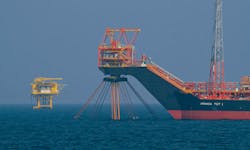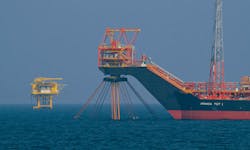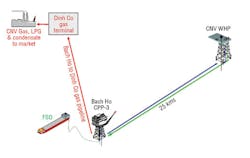SOCO helps Vietnam sustain oil production from deep-lying reservoirs
Jeremy Beckman
Editor, Europe
Vietnam has widespread gas resources, but the country’s main oil discoveries, and three-quarters of its oil production to date, have come from the Cuu Long and South Con Son basins offshore the southeast coast. Bach Ho, the country’s longest-producing and largest oilfield, is one of various fields located in fractured granite basement in Cuu Long, a Tertiary rift basin formed during rifting in the Early Oligocene. Other oil finds in the area have come from overlying Oligocene-Miocene shale, clastics and volcanic sections.
Although volumes in-place are in some cases substantial, the subsurface challenges of development have largely deterred western upstream investors. One exception is SOCO International, which has developed two fields in these geological settings in partnership with PetroVietnam and PTTEP, and which is now looking to prove a similar play in under-explored, deeper waters offshore eastern Vietnam.
SOCO’s founders are President and CEO, Edward Story, and Executive Vice President and Deputy CEO, Roger Cagle. Both had backgrounds in the financial sector: Story, who had worked for Exxon in the Far East before returning to the US in 1975, when the war in Vietnam ended, recruited Cagle to Exxon and the pair teamed up four years later at Superior Oil. The duo went on to form a joint venture with Snyder Oil Corp. which in the early 1990s developed fields in eastern Europe’s Perm region, at a time when PermNefteGas was joining the ranks of privatized Russian government entities.
This led to the formation of PermTex, with Lukoil later stepping into PermNefteGas’ position. In 1990, the joint venture with Snyder bought a controlling interest in Australian company Command Petroleum which had a subsidiary Holland Sea Search (HSS), at the time the second largest listed oil company on the Dutch Stock Exchange after Shell. This led to involvement in Bangladesh’s fledgling E&P industry and signing of the gas-prone offshore Sangu Sangu concession, followed in 1996 by start-up of the Ravva oilfield offshore eastern India. Soon afterwards, Story and Cagle sold both these interests to Edinburgh-based Cairn Energy, with HSS director Mike Watts also departing to head up Cairn’s exploration group (although Watts recently rejoined SOCO to spearhead the company’s expansion plans).
At that point in the 1990s, SOCO’s main assets were an exploration venture onshore Mongolia and production through PermTex. Vietnam had started opening up to foreign investors, including the US, and Story and Cagle, who had connections in the country, saw an opportunity for SOCO to join the legion of foreign oil companies bidding for shares in the country’s offshore blocks. “We went there with an ex-pat Vietnamese who had worked for Mobil in East Texas, but had gone back to Vietnam to teach reservoir engineering,” Story explained. “We knew we faced stiff competition in the bid round as at the time the Vietnamese were only interested in attracting big companies, but we managed to convince the authorities there that the prime oil-prospective region, the Cuu Long basin, should be partitioned via joint ventures, following the same model we had operated in Russia. We went on to help the government draw up the structure under which foreign parties fund exploration, with the Vietnamese state (via PetroVietnam) backing in for any subsequent production phase.”
These efforts led to SOCO securing interests in two 25-year offshore production concessions in the Cuu Long basin, both close to the Bach Ho field, as a partner in two joint operating companies (JOCs) that have since been aligned as a single management company. The other parties are PetroVietnam, the single largest shareholder, and Thailand’s PTTEP. Production from the Ca Ngu Vang (CNV) field in the western part of one concession, block 9-2, started in 2008, six years after discovery, while the Te Giac Trang field, discovered in 2005 in the northeastern part of block 16-1, produced first oil in 2011.
During the Vietnam conflict, Mobil drilled the initial discovery well on the giant basement Bach Ho field which the Gazprom/PetroVietnam joint venture Vietsovpetro went on to develop in the 1980s via a multi-platform complex. SOCO also saw basement oil potential in block 9-2, which was proven in the CNV field via a series of wells drilled during 2002-06. The development that followed involved installation of an unmanned wellhead platform exporting oil and gas to Bach Ho’s CPP3 central processing platform through two 26-km (16-mi), 10-in. subsea pipelines.
In 2013 the JOC received regulatory approvals for their full field development plan, which involved accessing previously untapped reserves in the southwestern part of CNV based on interpretation of 3D seismic over the area. The jackupNaga 2 spudded the CNV-7P development well in April 2014, but this had to be abandoned after failing three times to penetrate overlying conglomerates en route to the target. It proved to be a costly exercise, impacting the project’s economics; however, with rig rates still relatively low, the partners are considering another try.
“As a basement field, CNV is not a reservoir in the classic sense,” Story said, “so you are looking at fissures to bring out the oil through cracks in the granite. We have imaged off 3D seismic where most of the big seams area, and based on our interpretation of the reserves, we think this southwest section hasn’t really had suitable penetrations to date, and may contain a third of the field’s remaining reserves.”
Last year production from CNV averaged 6,211 boe/d, and rates are expected to remain stable for some time. The development is profitable even at an oil price in the low $20s, Story said. “The JOC owns the concession through 2029, and barring some unknown event, CNV should still be producing at that point. However, we need to re-evaluate our understanding of the drive mechanisms as the reservoir goes from a mainly oil to a gas-dominant reservoir, and at the moment we can’t recover enough of the oil. Knowledge of basement production remains limited: the conventional wisdom is that water injection-based pressure maintenance is critical to ensuring the highest possible recovery of the oil, but strangely, this turns out to be not necessarily the case.”
Re-assessing TGT reservoirs
Block 16-1 was originally awarded to a consortium of SOCO, Exxon, and Amerada Hess. “We negotiated the rights to the concession for two years, but finally Exxon departed” Cagle said. “Eventually - after drilling several basement dry holes Hess withdrew, paying us to take on their interest. The next well drilled was the TGT discovery well.”
The TGT field is in the northern part of block 16-1, 100 km (62 mi) southeast of Vung Tau and 20 km (12.4 mi) northwest of Bach Ho. It comprises various separate fault block accumulations of Early Miocene or Upper Oligocene age. The reservoirs feature vertically stacked sand layers with a limited distance between production zones and the oil-water contacts.
Development drilling has proven to be complex due to the vertical and horizontal compartmentalization of the reservoirs, necessitating vertical wellbores through the reservoirs to accommodate sliding sleeves, avoidance of high-angle step-outs to accommodate regular intervention, and use of water injection to maintain reservoir pressure. Development has been phased and focused on reserves from the different fault block accumulations. Current facilities comprise three wellhead platforms, with produced oil sent to the FPSOArmada TGT 1for processing and onward tanker export to regional refineries. Produced gas heads through a pipeline to Bach Ho for processing and transportation to shore to the Vung Tau power and gas plants.
Progressive development over the years and improved understanding of the reservoirs has led to production rising from the original government estimate of 10 MMbbl to the over 70 MMbbl. During 2016, output averaged 27,650 boe/d, although the facilities have nameplate capacity to produce up to 55,000 b/d of oil and 30 MMcf/d of gas.
Following a two-year hiatus, development drilling resumed late last year with the PetroVietnam Drilling jackup PVD-6 drilling two infill wells from the H4-wellhead platform, both encountering hydrocarbons throughout the targeted Miocene and Oligocene horizons. Results from these and interventions in existing wells helped boost gross production. The JOC plans to follow up later this year with two more infill wells from the southern H5-wellhead platform and the TGT-14X appraisal well on the H5 South fault block. In addition, the JOC has received approval for the TGT full field development plan to Vietnam’s authorities, detailing the scope for additional wells and options for facilities to increase fluid handling capacities.
“TGT is a multi-layered field with over 50 sands and thin horizons,” Story explained, “and the wells completed to date are not in all the sands. In some areas we didn’t complete in the most prolific sands as we are still trying to establish the characteristics of the field. Traditionally, Vietnam has a philosophy of ‘no barrel left behind,’ but with TGT what we are doing is drilling wells and trying to figure out what we have. You can get to the field edge and find water drive, then you need to figure out which are the zones with the higher water cut, and then go back in and drill those zones with the lower water cut. We are trying to explain to the Vietnamese that we can re-enter those wells later and shut them in as the water cut rises.”
According to Cagle, the suspension of drilling on TGT over the last two years was due to PetroVietnam’s budget cuts, in response to the lower oil price. The JOC has to have unanimity for any new investments to proceed, he said. “Last November, we had approval for a third well,” Story added, “but we didn’t have the necessary long-lead items, so since completing the two infill wells the rig has been stacked on the TGT production platform. Now we have approval to drill up to 18 wells under the full-field development plan, which is actually an outline based on a macro-environment. This works as follows: if the oil price is at a high enough level, the JOC looks to a more capital-intensive solution. If it is lower, an operating costs solution. “In the past, the Vietnamese government wouldn’t have considered committing funds for a new incremental scheme beyond a year. This solution is beyond 12 months, which is a new concept for them.”
“One thing we plan to do to solve TGT’s myriad production problems,” Cagle explained, “is to install water handling facilities on the H1 platform, raising the liquid handling capacity by 90,000 b/d to add to the FPSO’s nameplate capacity. We have tested the FPSO’s production capacity and have achieved oil rates over 65,000 b/d, even though the nameplate capacity is 55,000 b/d. But production is currently limited by the water handling capability: there are different fault blocks that we haven’t accessed in outlying parts of the license, with different anomalies at differing depths - but why drill wells in those areas when there are constraints on the liquids handling capacity?”
TGT has proven to be one of Vietnam’s most profitable fields, Cagle claimed, with operating costs falling at one point below $10/bbl, although $11 is more likely this year, due in part to market developments. Lack of new drilling activity generally caused the slowdown in steel and equipment manufacturing, which in turn extended the lead times for drilling the wells - hence the current stacking of thePVD-6. The impact on production therefore cancels out the benefits of the substantially lower day rate for the rig, currently $50,000/d compared with $120,000/d previously.
For both development projects the JOC has worked with three Vietnamese platform fabricators. “All are good,” Story said, “as are the quality of their drilling rigs - in fact, the best performance we have achieved on our wells has been with Vietnamese rigs. One reason is that the rigs are staffed by Vietnamese crews that have worked for PetroVietnam their entire careers, so they know the capabilities of the facilities.”
Phu Kanh potential
Unlike most other relatively small independent E&P companies SOCO is debt-free, and is now looking to expand elsewhere in Vietnam, the wider Asia region and North Africa, if suitable opportunities arise. “We think now is the right time to grow,” Story said. “Having come off the period of highs and lows, the industry is now at an intermediate level where things can stabilize. We think there will be a lot of M&A activity over the months ahead, and we don’t want to be left behind.”
One of the target areas is the Phu Kanh basin offshore central Vietnam, where the company has finished negotiations for a production-sharing contract (PSC) for blocks 125 and 126, adjacent to the coastline and in moderate to deepwater. Multiple structural and stratigraphic plays have shown up on available seismic, and SOCO sees potential for similar source, expulsion and migration of oil from basement as in the Cuu Long basin. JX Nippon Oil and Gas and ConocoPhillips are partners in an adjacent block, while ExxonMobil is developing a major gas discovery to the north and building an associated power station. Eni, too, has discovered gas nearby and another well on block 127 encountered oil.
No wells have ever been drilled on blocks 125 and 126, however, and if oil can be proven, it could be transformational for the company, Story suggested. Execution of the PSC, which SOCO would operate in the exploration phase in partnership with Vietnamese investment conglomerate SOVICO, should follow by mid-year. The main advantage of a PSC in Vietnam, Story explained, is that the operator has the ultimate say on how the project goes forward, while a JOC’s decisions depend on unanimity among the partners, something that is not always easy to achieve.



